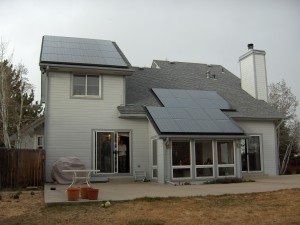I flipped the switch on the solar array today and watched my electric meter begin to run backwards, erasing not just today’s electricity usage, but most of yesterday’s as well. Today was a very sunny day in Colorado. These words were written on a computer that was, at the time of the writing, operating on solar energy alone.
For as long as I can recall, I’ve always wanted to own a house that ran on solar energy. My dad worked on the very first government communications satellites back in the 60’s and 70’s and he’d sometimes bring home bits and pieces of that project for my amusement. One of those early artifacts was a solar cell which is one of the technologies that allowed satellites to be practical in the first place. I remember being fascinated as I watched the solar cell power a small motor from a lamp. This was long before solar cells started showing up in calculators (which didn’t even exist at the time). The solar cells I played with back then are very similar to the ones that are now powering our entire house.

A 5.6 kW Solar Array Generates all our electricity
This solar installation uses a method called ‘net metering’, which feeds any excess electricity to the grid for use by my neighbors when the sun is shining. During this time, my meter runs backwards. After the sun goes down, my meter runs forward again. Based on the size of the array and our annual electricity usage, our house should have net zero electricity consumption over the course of the year. A net metering system has a few advantages over batteries because I don’t have to worry if we get several days with no sun, since I’m still hooked up to the grid. Also, a bank of batteries to hold just a day’s worth of electricity would be enormous, weighing over 2000 lbs. and they would also be costly. The savings from generating your own electricity are real, since for every kWh I generate, it means less coal or natural gas that needs to be burned back at the power plant.
I’ve always looked at the large south facing roof of our house as a perfect location for a solar array and now it’s here.
For those interested in specifics, the system includes 32 Sharp 176W panels connecting in 2 strings feeding a Sunny Boy inverter. Total capacity is 5.6 kW.

